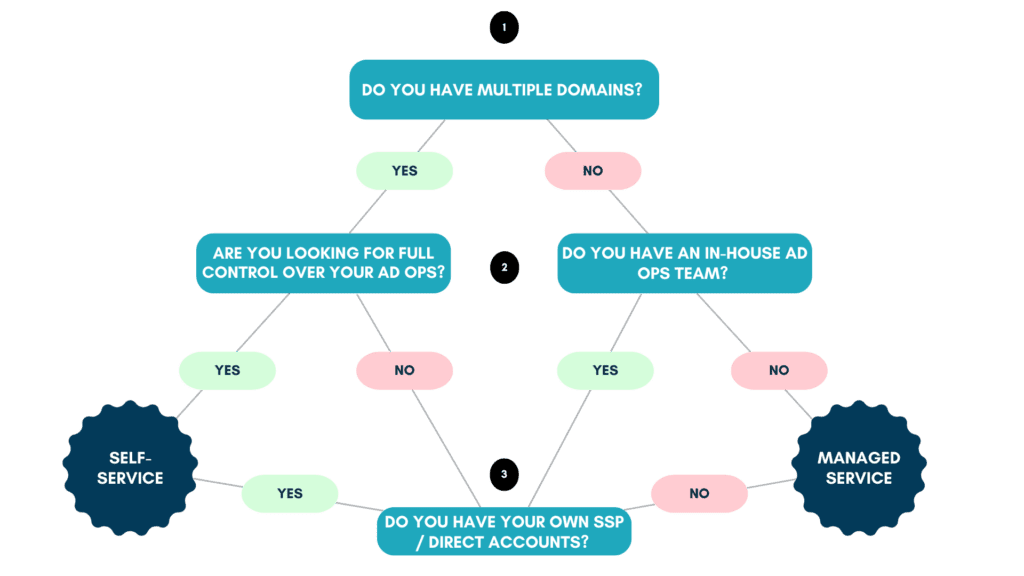Managed Service vs. Self-Service Programmatic Platforms
In today’s fast-paced digital world, programmatic advertising gives publishers the flexibility to monetize their platforms effectively. When it comes to choosing between a self-serve platform and a managed service, the decision often hinges on control, ease of use, and cost-efficiency.
Self-Service Boom: A Short Background
According to recent ANA research, publishers receive an average of just 36 cents for every dollar that enters DSPs and SSPs.
Publishers have long called for more flexible pricing options for their technology. The revenue share model, widely regarded as the industry standard for managed services, is no longer sustainable.
SaaS or self-service technology often uses a flat eCPM pricing model, offering smaller publishers from less economically developed regions a flexible and cost-effective solution that aligns with their unpredictable traffic levels.
However, publishers also don’t want to compromise on technology or capabilities that a platform offers. In practical terms this means they want access to advanced tech while retaining control to experiment with various settings and optimize setups—a level of flexibility that managed services often fail to provide.
This growing dissatisfaction has prompted many vendors on both the buy-side and sell-side to introduce self-serve platforms as part of their offerings.
Managed Service vs. Self-Service
Self-serve platforms, like Setupad’s Self-Serve, give publishers full control over their ad operations. With just a few clicks, they can easily manage demand partners, optimize in real-time, and experiment endlessly with ad formats and sizes. It’s an ideal solution for those looking to reduce IT bottlenecks and manage the entire ad process in-house. The user-friendly dashboard allows publishers to launch, adjust, and analyze their campaigns without relying on external management, offering both transparency and agility.
In contrast, a managed service takes care of the day-to-day operations for publishers, with experts handling everything on their behalf. Similar to outsourcing ad operations, this option is particularly beneficial for publishers who lack the resources or dedicated teams to manage complex ad operations internally. While managed services do not compromise on technology, they do limit control and transparency over the ad inventory. Typically, the AdOps team will monitor website performance and fine-tune ad delivery to maximize revenue growth. The most widely known example of a managed technology service for publishers is a Prebid / header bidding wrapper.

When Should Publishers Turn To Managed Service?
Turning to managed services for advertising management as a publisher is a smart decision when:
- Limited Resources: If your team lacks the expertise to manage complex ad operations, such as performing continuous optimizations, managing direct campaigns and demand partners, and troubleshooting technical issues, a managed service might be the way to go.
- Maximizing Revenue: Managed services often bring specialized knowledge and tools that can optimize ad placements, floor prices, and ad refresh rates, helping to maximize your revenue beyond what you or your team might achieve alone.
- Focus on Core Business: If ad management is taking too much time away from your core business activities (like content creation), outsourcing allows you to focus on what you do best while experts handle your ad tech.
- Scaling Needs: As you grow, you may require more sophisticated solutions like Prebid Server, which are costly and difficult to build in-house.
- Support: When you require constant monitoring, real-time support, and optimizations that go beyond what your internal team can provide, managed services offer a dedicated team of professionals to handle it and act as your ad tech consultants for privacy compliance (i.e., CMP), ad fraud (i.e., ads.txt, sellers.json) and Prebid configurations and beyond.
When Should Publishers Turn To Self-Service?
Turning to self-service platforms for advertising management can be beneficial for publishers in several situations:
- Cost Efficiency: If you’re looking to reduce the fees associated with managed services (i.e., move away from revenue share), self-service platforms will usually offer a more cost-effective solution. For example, Setupad offers a pay-as-you-go pricing model, and Sovrn offers a flat eCPM fee.
- In-House Expertise: If you have a dedicated team to manage complex ad operations, self-service platforms allow you to take full control and customize your approach. While it’s not a pre-requisite, any platform usually has a pretty steep learning curve, and a self-service platform is no exception.
- Desire for Flexibility: Self-service platforms provide flexibility in testing different setups, partners, and strategies without relying on a third party. Some platforms like Setupad allow you to do it with just a click, eliminating the need for IT support. It is an ideal choice for publishers who want to experiment with different ad formats, placements, and monetization strategies in real-time.
- Full Control Over Revenue: If you want complete control over your ad revenue and how your inventory is sold, self-service platforms enable you to manage floor prices, prioritize demand partners, and optimize yield without having to rely on a managed services provider to do this for you.
- Scaling Operations: While managed services may be the most cost-efficient option for smaller publishers, self-service platforms offer high scalability. Although self-service platforms are often marketed towards large publishers with multiple domains and dedicated ad ops teams, smaller publishers can still benefit from these platforms. They provide the flexibility to scale at your own pace, without constraints, and adapt to changing demands.
- Transparency and Data Ownership: Self-service platforms often offer more transparency, giving you access to hourly granular data and reporting. This is ideal if you value insights into your performance metrics and want to make data-driven decisions.
- Adapting to Industry Changes: For publishers who are agile and can quickly adapt to industry changes, self-service platforms offer the speed and control necessary to pivot as needed. A platform may come with built-in cookieless ID solutions or a CMP.

Final Thoughts
When deciding between managed services and self-serve platforms for programmatic advertising, the choice ultimately depends on your needs for control, resources, and expertise. Managed services are ideal for publishers looking to outsource the complexities of ad operations, leveraging expert knowledge to maximize revenue and free up time for core business activities.
On the other hand, self-serve platforms empower publishers to take full control over their ad tech, offering flexibility, cost-efficiency, and transparency for those with the capability and desire to manage operations in-house.


